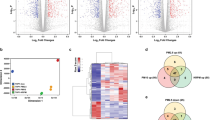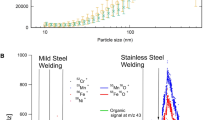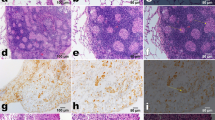Abstract
Anthropogenic carbon nanotubes, with a fibrous structure and physical properties similar to asbestos, have recently been found within human lung tissues. However, the reported carbon-nanotube-elicited pulmonary pathologies have been mostly confined to inflammatory or neoplastic lesions in the lungs or adjacent tissues. In the present study, we demonstrate that a single pulmonary exposure to multi-walled carbon nanotubes dramatically enhances angiogenesis and the invasiveness of orthotopically implanted mammary carcinoma, leading to metastasis and rapid colonization of the lungs and other organs. Exposure to multi-walled carbon nanotubes stimulates local and systemic inflammation, contributing to the formation of pre-metastatic and metastatic niches. Our study suggests that nanoscale-material-elicited pulmonary lesions may exert complex and extended influences on tumour progression. Given the increasing presence of carbon nanotubes in the environment, this report emphasizes the urgent need to escalate efforts assessing the long-term risks of airborne nanomaterial exposure in non-lung cancer progression.
This is a preview of subscription content, access via your institution
Access options
Access Nature and 54 other Nature Portfolio journals
Get Nature+, our best-value online-access subscription
$29.99 / 30 days
cancel any time
Subscribe to this journal
Receive 12 print issues and online access
$259.00 per year
only $21.58 per issue
Buy this article
- Purchase on Springer Link
- Instant access to full article PDF
Prices may be subject to local taxes which are calculated during checkout






Similar content being viewed by others
Data availability
The data that support the plots within this paper and other findings of this study are available from the corresponding author upon reasonable request.
References
Tran, P. A., Zhang, L. & Webster, T. J. Carbon nanofibers and carbon nanotubes in regenerative medicine. Adv. Drug Deliv. Rev. 61, 1097–1114 (2009).
Lee, S. W. et al. High-power lithium batteries from functionalized carbon-nanotube electrodes. Nat. Nanotechnol. 5, 531–537 (2010).
Cha, C., Shin, S. R., Annabi, N., Dokmeci, M. R. & Khademhosseini, A. Carbon-based nanomaterials: multifunctional materials for biomedical engineering. ACS Nano 7, 2891–2897 (2013).
De Volder, M. F., Tawfick, S. H., Baughman, R. H. & Hart, A. J. Carbon nanotubes: present and future commercial applications. Science 339, 535–539 (2013).
Lee, J. H. et al. Exposure assessment of carbon nanotube manufacturing workplaces. Inhal. Toxicol. 22, 369–381 (2010).
Howard, J. Current Intelligence Bulletin 65: Occupational Exposure to Carbon Nanotubes and Nanofibers (DHHS (NIOSH), 2013).
Poland, C. A. et al. Carbon nanotubes introduced into the abdominal cavity of mice show asbestos-like pathogenicity in a pilot study. Nat. Nanotechnol. 3, 423–428 (2008).
Ryman-Rasmussen, J. P. et al. Inhaled carbon nanotubes reach the subpleural tissue in mice. Nat. Nanotechnol. 4, 747–751 (2009).
Wang, P. et al. Multiwall carbon nanotubes mediate macrophage activation and promote pulmonary fibrosis through TGF-beta/Smad signaling pathway. Small 9, 3799–3811 (2013).
Guarnieri, M. & Balmes, J. R. Outdoor air pollution and asthma. Lancet 383, 1581–1592 (2014).
Liu, Y., Zhao, Y., Sun, B. & Chen, C. Understanding the toxicity of carbon nanotubes. Acc. Chem. Res. 46, 702–713 (2013).
Wang, L. et al. Carbon nanotubes induce malignant transformation and tumorigenesis of human lung epithelial cells. Nano Lett. 11, 2796–2803 (2011).
Shvedova, A. A. et al. MDSC and TGFβ are required for facilitation of tumor growth in the lungs of mice exposed to carbon nanotubes. Cancer Res. 75, 1615–1623 (2015).
Luanpitpong, S. et al. Induction of cancer-associated fibroblast-like cells by carbon nanotubes dictates its tumorigenicity. Sci. Rep. 6, 39558–39572 (2016).
Zheng, L. et al. Cardiovascular effects of pulmonary exposure to single-wall carbon nanotubes. Environ. Health Perspect. 115, 377–382 (2007).
Suzui, M. et al. Multiwalled carbon nanotubes intratracheally instilled into the rat lung induce development of pleural malignant mesothelioma and lung tumors. Cancer Sci. 107, 924–935 (2016).
Luanpitpong, S., Wang, L., Davidson, D. C., Riedel, H. & Rojanasakul, Y. Carcinogenic potential of high aspect ratio carbon nanomaterials. Environ. Sci. Nano 3, 483–493 (2016).
Xu, J. et al. Multi-walled carbon nanotubes translocate into the pleural cavity and induce visceral mesothelial proliferation in rats. Cancer Sci. 103, 2045–2050 (2012).
Donaldson, K. & Poland, C. A. Nanotoxicology: new insights into nanotubes. Nat. Nanotechnol. 4, 708–710 (2009).
Kuhn, C. 3rd et al. An immunohistochemical study of architectural remodeling and connective tissue synthesis in pulmonary fibrosis. Am. Rev. Respir. Dis. 140, 1693–1703 (1989).
Gabrilovich, D. I. & Nagaraj, S. Myeloid-derived suppressor cells as regulators of the immune system. Nat. Rev. Immunol. 9, 162–174 (2009).
Yilmaz, M., Christofori, G. & Lehembre, F. Distinct mechanisms of tumor invasion and metastasis. Trends Mol. Med. 13, 535–541 (2007).
Chaffer, C. L. & Weinberg, R. A. A perspective on cancer cell metastasis. Science 331, 1559–1564 (2011).
Charafe-Jauffret, E. et al. Breast cancer cell lines contain functional cancer stem cells with metastatic capacity and a distinct molecular signature. Cancer Res. 69, 1302–1313 (2009).
Liu, S. et al. Breast cancer stem cells transition between epithelial and mesenchymal states reflective of their normal counterparts. Stem Cell Rep. 2, 78–91 (2014).
Kitamura, T., Qian, B.-Z. & Pollard, J. W. Immune cell promotion of metastasis. Nat. Rev. Immunol. 15, 73–86 (2015).
Psaila, B. & Lyden, D. The metastatic niche: adapting the foreign soil. Nat. Rev. Cancer 9, 285–293 (2009).
Kusters, B. et al. Micronodular transformation as a novel mechanism of VEGF-A-induced metastasis. Oncogene 26, 5808–5815 (2007).
Hu, J. et al. Vascular endothelial growth factor promotes the expression of cyclooxygenase 2 and matrix metalloproteinases in Lewis lung carcinoma cells. Exp. Ther. Med. 4, 1045–1050 (2012).
Greenhough, A. et al. The COX-2/PGE2 pathway: key roles in the hallmarks of cancer and adaptation to the tumour microenvironment. Carcinogenesis 30, 377–386 (2009).
Hugo, H. J., Saunders, C., Ramsay, R. G. & Thompson, E. W. New insights on COX-2 in chronic inflammation driving breast cancer growth and metastasis. J. Mammary Gland Biol. Neoplasia 20, 109–119 (2015).
Nikota, J. et al. Stat-6 signaling pathway and not interleukin-1 mediates multi-walled carbon nanotube-induced lung fibrosis in mice: insights from an adverse outcome pathway framework. Part. Fibre Toxicol. 14, 37–57 (2017).
Wilczynski, J. R. & Duechler, M. How do tumors actively escape from host immunosurveillance? Arch. Immunol. Ther. Exp. ( Warsz. ) 58, 435–448 (2010).
Folkman, J. Role of angiogenesis in tumor growth and metastasis. Semin. Oncol. 29, 15–18 (2002).
Bielenberg, D. R. & Zetter, B. R. The contribution of angiogenesis to the process of metastasis. Cancer J. 21, 267–273 (2015).
Wu, M. et al. Case report. Lung disease in World Trade Center responders exposed to dust and smoke: carbon nanotubes found in the lungs of World Trade Center patients and dust samples. Environ. Health Perspect. 118, 499–504 (2010).
Kolosnjaj-Tabi, J. et al. Anthropogenic carbon nanotubes found in the airways of Parisian children. EBioMedicine 2, 1697–1704 (2015).
Oberdorster, G., Castranova, V., Asgharian, B. & Sayre, P. Inhalation exposure to carbon nanotubes (CNT) and carbon nanofibers (CNF): methodology and dosimetry. J. Toxicol. Environ. Health B Crit. Rev. 18, 121–212 (2015).
Liu, Y. et al. Gd-metallofullerenol nanomaterial as non-toxic breast cancer stem cell-specific inhibitor. Nat. Commun. 6, 5988–6005 (2015).
Park, E. K. et al. Optimized THP-1 differentiation is required for the detection of responses to weak stimuli. Inflamm. Res. 56, 45–50 (2007).
Acknowledgements
This work was supported by the National Key R&D Program of China (2016YFC1302305, 2016YFA0201600, 2016YFE0133100), the National Natural Science Foundation of China (81672615, 815022829, 91543206, 31622026, 31700879), the Science Fund for Creative Research Groups of the National Natural Science Foundation of China (11621505), the Shenzhen Development and Reform Commission Subject Construction Project [2017]1434, the Bureau of International Co-operation Chinese Academy of Sciences (GJHG1852) and the National Science Fund for Distinguished Young Scholars (11425520).
Author information
Authors and Affiliations
Contributions
T.Z. and C.C. conceived the project and supervised the study. T.Z., C.C., X.L. and Y.Z. designed the experiments. X.L. and Y.Z. performed experiments with assistance from R.B., Z.W., W.Q., L.Y., R.C., H.Y., Y.L., T.L. and V.P.; X.L. and Y.Z. analysed the data. T.Z., C.C. and X.L. co-wrote the paper. All authors discussed the results and commented on the manuscript.
Corresponding authors
Ethics declarations
Competing interests
The authors declare no competing interests.
Additional information
Journal peer review information: Nature Nanotechnology thanks Wolfgang Kreyling, Iseult Lynch and other anonymous reviewer(s) for their contribution to the peer review of this work.
Publisher’s note: Springer Nature remains neutral with regard to jurisdictional claims in published maps and institutional affiliations.
Supplementary information
Supplementary Information
Supplementary Figs. 1–19, Supplementary Table 1–5
Rights and permissions
About this article
Cite this article
Lu, X., Zhu, Y., Bai, R. et al. Long-term pulmonary exposure to multi-walled carbon nanotubes promotes breast cancer metastatic cascades. Nat. Nanotechnol. 14, 719–727 (2019). https://doi.org/10.1038/s41565-019-0472-4
Received:
Accepted:
Published:
Issue Date:
DOI: https://doi.org/10.1038/s41565-019-0472-4
This article is cited by
-
Ropivacaine as a novel AKT1 specific inhibitor regulates the stemness of breast cancer
Journal of Experimental & Clinical Cancer Research (2024)
-
Nanosensor detection of reactive oxygen and nitrogen species leakage in frustrated phagocytosis of nanofibres
Nature Nanotechnology (2024)
-
Progress and Challenges of Water-soluble NIR-II Organic Fluorophores for Fluorescence Imaging in vivo
Chemical Research in Chinese Universities (2024)
-
TiO2 nanoparticles promote tumor metastasis by eliciting pro-metastatic extracellular vesicles
Journal of Nanobiotechnology (2023)
-
Near-infrared luminescence high-contrast in vivo biomedical imaging
Nature Reviews Bioengineering (2023)



